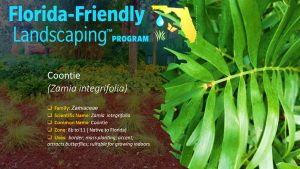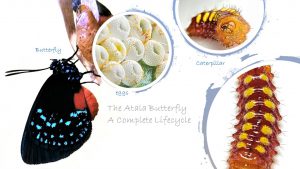Article by UF/IFAS Extension Broward County Urban Horticulture Agent Lorna Bravo
Plants in your landscape that provide food, water, and shelter will attract Florida’s diverse wildlife. What is black, blue-green with flashes of a red tail? You guessed it, the Atala butterfly. Its scientific name is Eumaeus atala. They fly like a moth, please you with a good perch for photos, and stick around once you give them plenty of host plants and likable nectar.
What is the secret to their visit?
It is called Coontie or Zamia integrifolia. This plan is a cycad. Cycads are an ancient group of tropical and subtropical plants that have existed since the age of dinosaurs. The Atala butterflies use as host with the advantage of the plants’ toughness and toxicity. Cycads – Gardening Solutions – University of Florida, Institute of Food and Agricultural Sciences (ufl.edu)

Did you know that the name Coontie or koonti comes from the Seminole Native American language?
This cycad inhabits all habitats, including well-drained, sandy soils though it prefers filtered light or partial shade. The Coontie is native to most of Florida’s peninsula and southeastern Georgia east of the Apalachicola River.
One can find Atala butterflies in southeastern Florida, Palm Beach, Broward, and Miami-Dade county. New Atala colony introduction took place in Martin, Monroe, and Collier counties. In Fort Pierce, they are found at the Fort Pierce Inlet State Park.
History
This plant has a fascinating history. Coontie was once known as “Florida Arrowroot.” It was useful to the early settlers and Native Americans of South Florida. The starchy tuber-root and stems made flour after the process of removing, washing out the poison cycasin.
Atala Butterfly Challenges
Were you aware that between 1937 and 1959, the Florida Atala butterfly disappeared? Many thought it was it was extinct. The great news? A colony of butterflies was rediscovered in 1979 by Roger Hammer, naturalist, and author on Key Biscayne, Florida. Since then, Atala populations have rebounded in South Florida. Gardeners avidly plant Coontie in hopes of seeing this unique butterfly.
Did you know that the Coontie plant is part of Florida’s Commercially Exploited Plant List? Collection of the Coontie from the wild is prohibited.
The Atala Butterfly Full Life Cycle
Watch this fascinating video of the complete life cycle of the rare Atala butterfly created by UF/IFAS Extension Broward County Master Gardener Volunteer Amy Rielly. Understand what the eggs look like, the caterpillars, and the adult butterfly stage. The video has extra footage of eggs hatching!

Do you want to invite this miracle in your yard? Provide for Wildlife
Learn about our Florida-Friendly Landscaping program and its nine principles. As urban areas are rapidly increasing worldwide, our urban yards are the first defense line preserving Florida’s fragile environment. Invite Coonties in your yard. If you plant them, they will come. Plant nectar sources. Select plants with seeds, fruit, flowers, or berries. Contact our Broward Extension office for a list of plants you can invite in your yard to support wildlife and consider certifying your yard as a Florida-Friendly Landscape. And remember, where the Coontie is, the Atala butterfly has shown up—interested to have your yard certified as a Florida-Friendly Landscape?
Florida Friendly Landscaping in South Florida.
The Florida-Friendly Landscaping™ (FFL) program operates under the UF/IFAS Center for Landscape Conservation & Ecology (CLCE). The Florida Friendly Landscaping program is an educational outreach program informing homeowners and professionals how they can be more environmentally friendly with their landscape care practices. The Florida-Friendly Landscaping™ Program’s mission is to educate Floridians about science-based, environmentally friendly landscaping practices and encourage them to conserve and protect our water resources by applying its nine principles. Recognizing the home landscape as part of a more extensive natural system will help us make sound decisions in creating a Florida-Friendly yard and help protect Florida’s natural environment for future generations.
Contact UF/IFAS Extension Broward County Florida-Friendly Landscaping Program. Email: Lorna Bravo lbravo1@ufl.edu or Anthony Gross @anthony.gross@ufl.edu
Resources
You can read more about Florida Atala butterfly and coonties here:
- ENH117/MG347: Florida Coonties and Atala Butterflies (ufl.edu)
- EENY-641/IN326: Atala Butterfly, Atala Hairstreak, Coontie Hairstreak, Eumaeus atala Poey 1832 (Insecta: Lepidoptera: Lycaenidae) (ufl.edu)
Contact us
You can follow our Facebook page at @http://facebook.com/urbanhortbrowardVisit our Website@ http://sfyl.ifas.ufl.edu/broward/urban-horticulture/
Visit our YouTube Channel at https://tinyurl.com/urbanhhortbcyoutube
Our Twitter page: https://twitter.com/HortUrban
Our Instagram page:@urbanhortbroward
 1
1

Comments are closed.